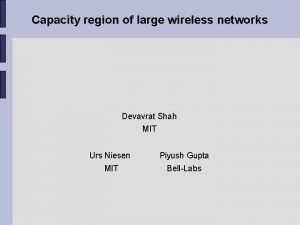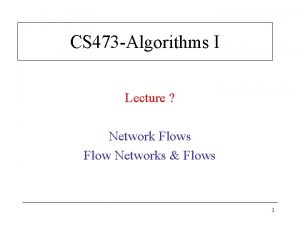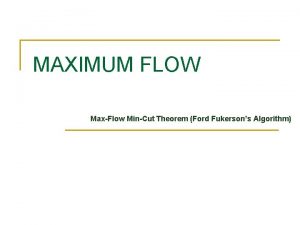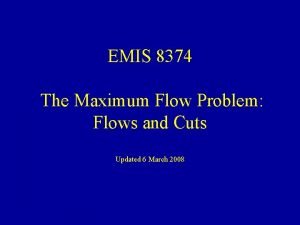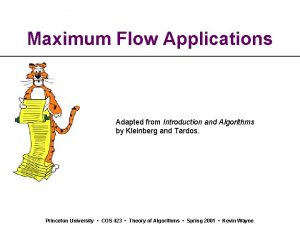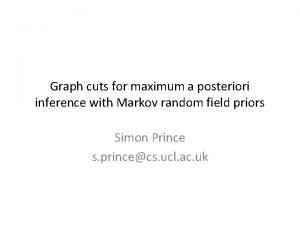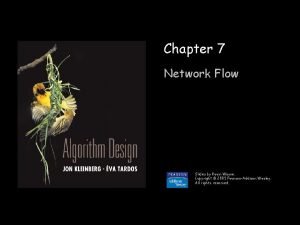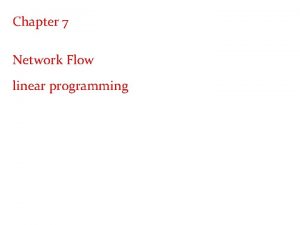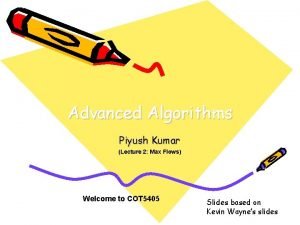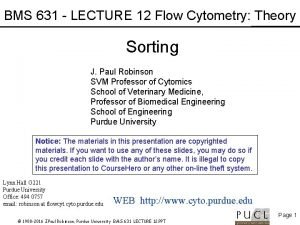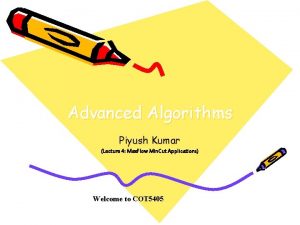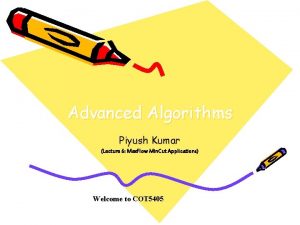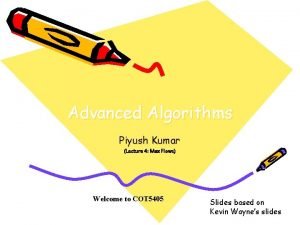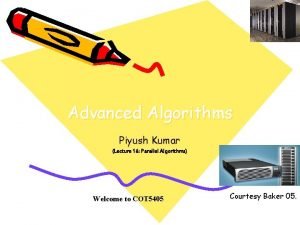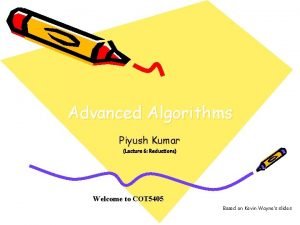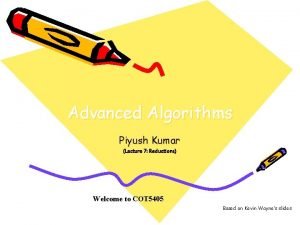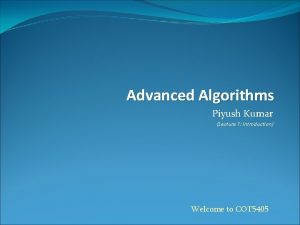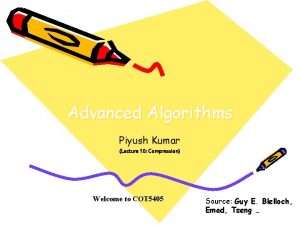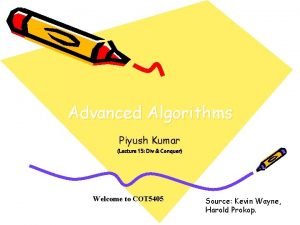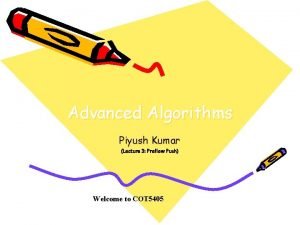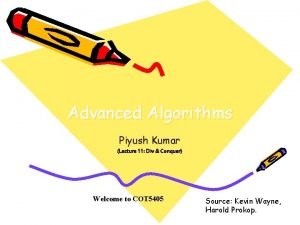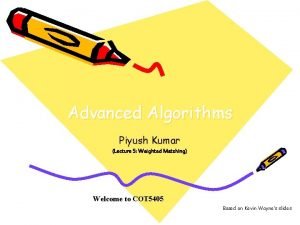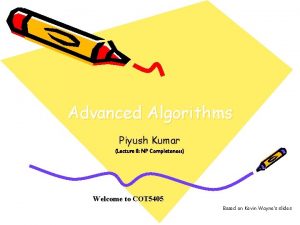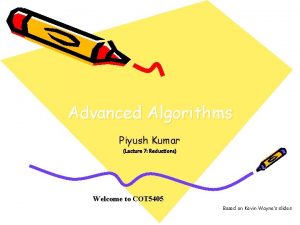Advanced Algorithms Piyush Kumar Lecture 6 Max Flow












![Marriage Theorem • Marriage Theorem. [Frobenius 1917, Hall 1935] Let G = (L R, Marriage Theorem • Marriage Theorem. [Frobenius 1917, Hall 1935] Let G = (L R,](https://slidetodoc.com/presentation_image/0bbf92fa44ea52701e416f65daa8bccc/image-13.jpg)
















- Slides: 29

Advanced Algorithms Piyush Kumar (Lecture 6: Max. Flow Min. Cut Applications) Welcome to COT 5405

Announcements • Homework 2 Will be announced soon. • Collect graded homework 1 from me after class.

Today • Complete Preflow Push • Bipartite matching/Hall’s theorem • Application of Max. Flow Min. Cut – Image segmentation – Edge Disjoint paths

Applications Max Flow Min Cut

Bipartite Matching • Matching. – Input: undirected graph G = (V, E). – M E is a matching if each node appears in at most edge in M. – Max matching: find a max cardinality matching.

Bipartite Matching • Bipartite matching. – Input: undirected, bipartite graph G = (L R, E). – M E is a matching if each node appears in at most edge in M. – Max matching: find a max cardinality matching. 1 1' 2 2' matching 1 -2', 3 -1', 4 -5' L 3 3' 4 4' 5 5' R

Bipartite Matching • Bipartite matching. – Input: undirected, bipartite graph G = (L R, E). – M E is a matching if each node appears in at most edge in M. – Max matching: find a max cardinality matching. 1 1' 2 2' max matching 1 -1', 2 -2', 3 -3' 4 -4' L 3 3' 4 4' 5 5' R

Bipartite Matching • Max flow formulation. – Create digraph G' = (L R {s, t}, E' ). – Direct all edges from L to R, and assign infinite (or unit) capacity. – Add source s, and unit capacity edges from s to each node in L. – Add sink t, and unit capacity edges from each node in R to t. G' 1 1 s L 1' 2 2' 3 3' 4 4' 5 5' 1 t R

Bipartite Matching: Proof of Correctness • Theorem. Max cardinality matching in G = value of max flow in G'. • Pf. – Given max matching M of cardinality k. – Consider flow f that sends 1 unit along each of k paths. – f is a flow, and has cardinality k. ▪ G 1 1' 2 2' 3 3' 4 5 1 1 1' 2 2' 3 3' 4' 4 4' 5' 5 5' s 1 t G'

• • Bipartite Matching: Proof of Correctness Theorem. Max cardinality matching in G = value of max flow in G'. Pf. – Let f be a max flow in G' of value k. – Integrality theorem k is integral and can assume f is 0 -1. – Consider M = set of edges from L to R with f(e) = 1. • each node in L and R participates in at most one edge in M • |M| = k: consider cut (L s, R t) ▪ 1 1 s G' 1' 1 1 1' 2 2' 3 3' 4 4' 5 5' t G

Perfect Matching • Def. A matching M E is perfect if each node appears in exactly one edge in M. • Q. When does a bipartite graph have a perfect matching? • Structure of bipartite graphs with perfect matchings. – Clearly we must have |L| = |R|. – What other conditions are necessary? – What conditions are sufficient?

Perfect Matching • Notation. Let S be a subset of nodes, and let N(S) be the set of nodes adjacent to nodes in S. • Lemma. If a bipartite graph G = (L R, E), has a perfect matching, then |N(S)| |S| for all subsets S L. • Pf. Each node in S has to be matched to a different node in N(S). 1 1' 2 2' No perfect matching: S = { 2, 4, 5 } L 3 3' 4 4' 5 5' N(S) = { 2', 5' }. R
![Marriage Theorem Marriage Theorem Frobenius 1917 Hall 1935 Let G L R Marriage Theorem • Marriage Theorem. [Frobenius 1917, Hall 1935] Let G = (L R,](https://slidetodoc.com/presentation_image/0bbf92fa44ea52701e416f65daa8bccc/image-13.jpg)
Marriage Theorem • Marriage Theorem. [Frobenius 1917, Hall 1935] Let G = (L R, E) be a bipartite graph with |L| = |R|. Then, G has a perfect matching or there is exists S L such that |N(S)| < |S|. Pf: When there is no perfect matching, Use max-flow min-cut theorem on a bipartite graph, to find the cut(A’, B’) < n. Let A = L ∩ A’ Claim 1: N(A) A’ Claim 2: |R ∩ A’| >= N(A) Claim 3: |L ∩ B’ | = n - |A| Claim 4: c(A’, B’) = |L ∩ B’ | + |R ∩ A’| < n

Bipartite Matching: Running Time • Which max flow algorithm to use for bipartite matching? – Generic augmenting path: O(m val(f*) ) = O(mn). – Capacity scaling: O(m 2 log C ) = O(m 2). – Shortest augmenting path: O(m n 1/2). • Non-bipartite matching. – Structure of non-bipartite graphs is more complicated, but well-understood. [Tutte-Berge, Edmonds-Galai] – Blossom algorithm: O(n 4). [Edmonds 1965] – Best known: O(m n 1/2). [Micali-Vazirani 1980]

7. 10 Image Segmentation 15

Image segmentation

Image Segmentation • Image segmentation. – Central problem in image processing. – Divide image into coherent regions. • Ex: To recognize a hand (or face/iris/fingerprint) from the background. (And find out if the person is known to the system)

Image Segmentation • Foreground / background segmentation. – Label each pixel in picture as belonging to foreground or background. – V = set of pixels, E = pairs of neighboring pixels. – ai 0 is likelihood pixel i in foreground. – bi 0 is likelihood pixel i in background. – pij 0 is separation penalty for labeling one of i and j as foreground, and the other as background. • Goals. – Accuracy: if ai > bi in isolation, prefer to label i in foreground. – Smoothness: if many neighbors of i are labeled foreground, we should be inclined to label i as foreground. – Find partition (A, B) that maximizes: foreground background

Image Segmentation • Formulate as min cut problem. – Maximization. – No source or sink. – Undirected graph. • Turn into minimization problem. – Maximizing is equivalent to minimizing – or alternatively

Image Segmentation • Formulate as min cut problem. – G' = (V', E'). – Add source to correspond to foreground; add sink to correspond to background – Use two anti-parallel edges instead of undirected edge. pij pij aj s i pij bi G' j t

Image Segmentation • Consider min cut (A, B) in G'. – A = foreground. if i and j on different sides, pij counted exactly once – Precisely the quantity we want to minimize. aj i s A G' pij bi j t

Edge Disjoint paths

Edge Disjoint Paths • Disjoint path problem. Given a digraph G = (V, E) and two nodes s and t, find the max number of edge-disjoint s-t paths. • Def. Two paths are edge-disjoint if they have no edge in common. • Ex: communication networks. s 2 5 3 6 4 7 t

Edge Disjoint Paths • Disjoint path problem. Given a digraph G = (V, E) and two nodes s and t, find the max number of edge-disjoint s-t paths. • Def. Two paths are edge-disjoint if they have no edge in common. • Ex: communication networks. s 2 5 3 6 4 7 t

Edge Disjoint Paths • Max flow formulation: assign unit capacity to every edge. 1 s 1 1 1 t 1 1 • • Theorem. Max number edge-disjoint s-t paths equals max flow value. Pf. – Suppose there are k edge-disjoint paths P 1, . . . , Pk. – Set f(e) = 1 if e participates in some path Pi ; else set f(e) = 0. – Since paths are edge-disjoint, f is a flow of value k. ▪

Edge Disjoint Paths • Max flow formulation: assign unit capacity to every edge. 1 s 1 1 1 t 1 1 • • Theorem. Max number edge-disjoint s-t paths equals max flow value. Pf. – Suppose max flow value is k. – Integrality theorem there exists 0 -1 flow f of value k. – Consider edge (s, u) with f(s, u) = 1. • by conservation, there exists an edge (u, v) with f(u, v) = 1 • continue until reach t, always choosing a new edge – Produces k (not necessarily simple) edge-disjoint paths. ▪ can eliminate cycles to get simple paths if desired

Menger’s theorem • In every directed graph with nodes s and t, the maximum number of edge-disjoint s-t paths is equal to the minimum number of edges whose removal separates s from t. • Special case of Max. Flow Min. Cut theorem. • We cud use this theorem instead of the Max. Flow Min. Cut theorem in the proof of Hall’s theorem.

Homework 2 • Read and design power point/latex slides (use beamer) (any one of the following) – – – – Baseball elimination Weighted matching with costs Project selection Airline scheduling Survey design Circulation and demands Advertising policy (Yahoo) Problem : 16 Search cohesive groups : Problem 46.

References • R. K. Ahuja, T. L. Magnanti, and J. B. Orlin. Network Flows. Prentice Hall, 1993. (Reserved in Dirac) • K. Mehlhorn and S. Naeher. The LEDA Platform for Combinatorial and Geometric Computing. Cambridge University Press, 1999. 1018 pages
 Dr piyush jain rml hospital
Dr piyush jain rml hospital Piyush gupta mit
Piyush gupta mit Analysis of algorithms lecture notes
Analysis of algorithms lecture notes Introduction to algorithms lecture notes
Introduction to algorithms lecture notes Interpolation search formula
Interpolation search formula Absolute maximum and minimum
Absolute maximum and minimum 01:640:244 lecture notes - lecture 15: plat, idah, farad
01:640:244 lecture notes - lecture 15: plat, idah, farad Advanced inorganic chemistry lecture notes
Advanced inorganic chemistry lecture notes Max flow lp
Max flow lp Flow g cut
Flow g cut Flow network
Flow network Max flow
Max flow Max flow lp
Max flow lp Alto flujo vapotherm
Alto flujo vapotherm Max flow
Max flow Max flow
Max flow Max flow
Max flow Max flow
Max flow Max flow
Max flow Max flow min cut algorithm
Max flow min cut algorithm Flow cytometry lecture
Flow cytometry lecture Fio2 calculation nasal cannula
Fio2 calculation nasal cannula Venturi mask flow rate
Venturi mask flow rate 3 liters fio2
3 liters fio2 Turbulent flow vs laminar flow
Turbulent flow vs laminar flow Internal versus external flow
Internal versus external flow Energy naturally flows from warmer matter to cooler matter.
Energy naturally flows from warmer matter to cooler matter. Flow of energy vs flow of matter
Flow of energy vs flow of matter Transform flow and transaction flow
Transform flow and transaction flow Data flow structure
Data flow structure

